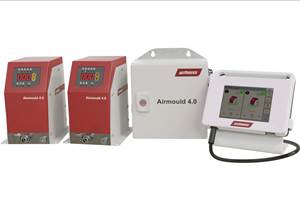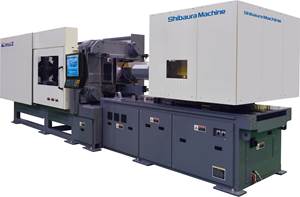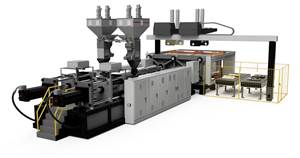Enhanced Gas-Assist Molding Shortens Cycles, Cuts Downtime
Close Up: Gas Assist
A pair of new technologies, one proven at several molders in Europe and a second just now ready for commercialization, is said to improve on current gas-assist injection molding techniques with up to 30% faster cycles and up to 90% reduced downtime for maintenance of molds and gas injectors.
A pair of new technologies, one proven at several molders in Europe and a second just now ready for commercialization, is said to improve on current gas-assist injection molding techniques with up to 30% faster cycles and up to 90% reduced downtime for maintenance of molds and gas injectors. Together, these two technologies are dubbed eGAIM, or Enhanced Gas-Assist Injection Molding by Linde North America, Inc., Murray Hill, N.J., a major supplier of industrial gases. Linde developed eGAIM in close cooperation with a German molder, Engel Formenbau und Spritzguss GmbH (no relation to Engel, the injection machinery supplier.)
IMPROVED COOLING BY GAS FLUSHING
Engel started working with Linde eight years ago to improve molding of ABS and PC/ABS refrigerator handles. Two years ago, Engel applied the new know-how to automotive parts such as PP grab handles. Engel’s initial motivation was to shorten cycle times of appliance handles. Even with gas assist, these were still thick-walled parts. Despite internal gas channels ranging from 10-12 in. to as long as 3 ft or more, the injected gas remained trapped for the length of the cycle and quickly became quite hot.
The solution was to cool parts not just from the outside, as usual, but from the inside as well by continuously flushing gas through the channel. Linde recommends this flushing approach as a completely dry and simpler alternative to water injection, which also cools the part from inside.
Flushing the inside of the part requires a secondary gas injector. Engel realized an immediate improvement in cycle time of 20-30% by flushing nitrogen through the handles. Engel also was one of the first molders to benefit from Linde’s new Presus N10 liquid-nitrogen pressure booster. It can pressurize nitrogen from a bulk tank up to 4500 psi for gas-assist molding and at flow rates up to 4600 scf/hr, while using up to 90% less energy than standard gas compressors. What’s more, the Presus N10 operates completely oil-free, unlike other compressors, so no oil is introduced into the part or mold. (The Presus N10 was shown at NPE2012 in Orlando, Fla. See our August Keeping Up With Technology section.)
Gas-assist molders like Engel, that already have a optimized nitrogen supply system can continue to use it with eGAIM. But for new installations, especially for more complex mold geometries and larger parts with big gas channels, Linde recommends a new technology using CO2 instead. That’s because denser CO2 has much higher heat-removal capacity than nitrogen. CO2 is ususally used when there is no second gas injector available, achieving similar cycle-time reduction as nitrogen flushing. It can also be used to perform flushing, which can speed cycles by another 20-30% in some cases, Linde says. (Linde also offers a Presus C pressure booster for CO2.)
INERTING THE CAVITY BEFORE INJECTION
The second main element of eGAIM is the just-now commercialized technique of flushing the mold cavity with inert gas immediately before plastic injection. When melt enters the cavity, it pushes residual air through the gas injector back into the gas pressure-control module. After the cavity fills, the next step is to inject gas. However, there may be 6-8 ft of supply hoses filled in part with residual air from the cavity, so the first gas entering the cavity is air, not nitrogen (or CO2). At high temperatures and pressures, this air oxidizes the polymer, producing dark, viscous byproducts that can clog injector nozzles and invade the rest of the gas supply system.
The solution is to flush the cavity with a shot of inert gas before the melt is injected. This generally requires a separate injector from the one that hollows out the part with gas. Engel, which runs 24/6, found that “inerting” the cavity prior to injection reduced its maintenance downtime by 90%. For one part, maintenance was reduced from 1 hr every 8 hr, or a total of about 18 hr a week, to just 1 hr a week. Not only did that mean more machine uptime and reduced labor cost, but also reducing the number of startups and the scrap involved in getting back into stable production.
Related Content
Internal Gas Pressure Molding Offers Sustainability Benefits
Wittmann Battenfeld says its upgraded Airmould 4.0 technology, which features a more compact footprint, saves material and cycle time — thereby also cutting energy use.
Read MoreCompletely Connected Molding
NPE2024: Medical, inmold labeling, core-back molding and Industry 4.0 technologies on display at Shibaura’s booth.
Read MoreStructural Foam Injection Molding Line Extended
At K 2022, Wilmington Machinery introduced the dual-injection Lumina MP1200 medium pressure molding machine.
Read MoreFakuma 2023: Wittmann Battenfeld Expands All-Electric Line, Direct-Current Capabilities
Wittmann Battenfeld will introduce the new EcoPower B8X injection molding machine line and show direct current as an energy source for a concept machine that will power its own robot.
Read MoreRead Next
Troubleshooting Screw and Barrel Wear in Extrusion
Extruder screws and barrels will wear over time. If you are seeing a reduction in specific rate and higher discharge temperatures, wear is the likely culprit.
Read MoreWhy (and What) You Need to Dry
Other than polyolefins, almost every other polymer exhibits some level of polarity and therefore can absorb a certain amount of moisture from the atmosphere. Here’s a look at some of these materials, and what needs to be done to dry them.
Read MoreLead the Conversation, Change the Conversation
Coverage of single-use plastics can be both misleading and demoralizing. Here are 10 tips for changing the perception of the plastics industry at your company and in your community.
Read More


























